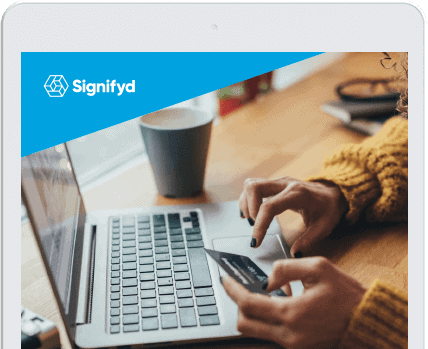The explosive growth of digital transactions year over year has pushed ecommerce leaders to implement strong anti-fraud strategies. According to Statista, the current transactional value of digital remittances in the U.S. is upwards of $80 billion. The group also projects that by 2023, the number of users is expected to reach 13.2 million. Organizations that offer technological solutions to reduce ecommerce fears coupled with advancements in payment security such as blockchain are the best line of defense.
Blockchain is growing in importance across many different industries. The technology has the potential to change the fraud protection game. It’s important for retail leaders to understand what blockchain is (and isn’t) and what it can (and can’t) do. This is a brief overview of how blockchain can boost fraud protection strategies and address common problems in retail like supply chain and data security.
- Blockchain can fill several needs for major retailers by offering unprecedented advancements in payment privacy and security.
- The inner workings and intricacies of the blockchain network can provide a solid defense against hackers and scammers.
- Retail giants like Nestle and Walmart have begun to integrate blockchain technology into their business strategies — and are seeing excellent results.
First things first: what is blockchain?
Most people can’t get past trying to understand what blockchain is, so they fail to see the fundamentals of how this system works. The word “block” refers to digital information, and the database where the data lives represents the “chain.” Examples of blocks may include transactional information (like date, time, and purchase amount) or purchaser information.
Splunk explains how the most well-known application of blockchain in cryptocurrency can support data security in any industry:
Blockchain is a decentralized, distributed electronic database shared across a public or private network. Every transaction in a blockchain database is shared among a number of users, each one verifying that the database is accurate and preventing unauthorized transactions. The technology has implications far beyond financial transactions. Blockchain might be the key to guarding valuable data from security threats and ensuring its integrity.
This technology differs from other security and data protection methods. It does not use your name or any personal information that could compromise your identity. Instead, it creates a unique digital code referred to as a “hash.” After this code is generated, the transaction is considered “hashed.”
Before a block of data can be stored in the blockchain along with other sets of data, a few other actions must take place. Let’s use an ecommerce scenario. First, a consumer must initiate an ecommerce transaction. Next, the blockchain network must verify the transaction. Then, the verified transaction is stored in a block. Finally, a hashed block is added to the blockchain.
Now that you know the basics of how blockchain works, you can start thinking of how to apply the technology to your data, privacy and payments systems strategies.
Blockchain promotes payment data privacy
One key benefit of using blockchain is that it creates a level of transparency for customers. When payment processing occurs, consumers want to know where and how their information is transmitted, and as more customers become concerned with where the goods they buy come from, blockchain can be a value add for retailers looking for an edge in gaining new customers and retaining current customer relationships.
Blockchain adds a level of transparency to data and privacy protection. Every time a new block is added, it is publicly available for view. Just hearing this causes some people to question how secure it is. However, since blockchain spreads information across a network of computers, hackers can’t manipulate data because they would have to upset every copy of the blockchain on the network.
Although most of the information is anonymous, there are a few minor exceptions. User details such as a digital signature or username are recorded, but the public does not have access to identifying information about the actual users that performed the transactions.
Privacy and data protection is a blind spot for many technologies. It’s important to integrate safety for consumers’ information into retail strategies. Blockchain can help address some of the security concerns.
Payments security beyond cryptocurrency
Don and Alex Tapscott, authors of the book Blockchain Revolution, share insights into how blockchain impacts technological fraud protection: “The blockchain is an incorruptible digital ledger of economic transactions that can be programmed to record not just financial transactions but virtually everything of value.” Blockchain’s public ledger of value helps reduce the occurrence of fraudulent transactions. Specifically, blockchain technology brings anonymity that makes digital payment transactions more secure.
Blockchain enhances online payment security in many ways. Blocks are difficult to edit and ultimately impossible to delete, based on how hashes work. A hash is tied to its respective block and to the one before it. An altered hash changes the hash code. This is a near-foolproof way to ensure that people don’t waste time trying to manipulate information stored in the block.
Computers within the blockchain also have layers of added security. The blockchain network performs tests on computers before they can join the network. This deters hackers because they would have to implement sophisticated, time-consuming methods in an attempt to attack the blockchain. Based on the intricacy of the blockchain network, the energy that hackers would have to invest is simply not worth the hassle — especially considering the poor odds that they could even penetrate the network.
It’s time for blockchain to step out of the cryptocurrency shadow. And it’s time for retail leaders to look at how blockchain can be applied to their biggest business problems.
Retail use cases for blockchain
Blockchain technology emerged as a solution to protect bitcoin and other digital currencies. Outside of its original use, blockchain has been so monumental that mega-retailers like Alibaba, Nestle and Walmart have started using it.
Alibaba uses blockchain technology to enhance food safety by generating a food-tracking system. Nestle recently announced that it will implement a blockchain strategy that allows consumers to track their food from the farm to its factories.
Similarly, Avanade, a joint venture of Accenture and Microsoft that focuses on technology development, is behind a block chain technology, Blockaccino, that traces coffee beans from farm, to warehouse, to roastery to cafe to coffee cup.
Matt Joe, who was Avanade’s chief technology innovation officer at the time, talked to us in the video below about the way applying blockchain for transparency can help retailers better connect with consumers. Blockchain technology in retail offers an added layer of omnichannel support by giving retailers an unprecedented new approach to managing anything, including payments and security.
Blockchain is more than just cryptocurrency and Bitcoin. Forward-thinking merchants and retail leaders can apply blockchain to their accounting, fraud prevention and supply chain operations, with more future uses likely to come as retail technology continues to evolve. This new technology can open doors to smarter and better retail processes. Start thinking about blockchain as the foundation of a new retail technology era.









